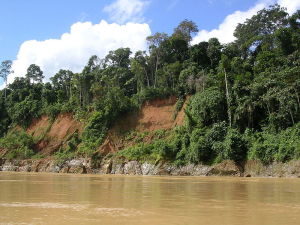
In a newly published article in Science Magazine, contributing correspondent Andrew Lawler reports in detail the evolving crisis of events and issues surrounding the recent activities of isolated forest tribes inhabiting the deepest regions of the Peruvian rainforest. What could be described as “throwbacks” to a largely bygone prehistoric era, these people have maintained a traditional “hunter-gatherer” lifestyle, separate from the modern economies that surround them in both Peru and Brazil.
Villagers living along the banks of the Curanja River in the rainforest of eastern Peru are reporting frequent sightings and “raids” from these mysterious forest people, says Lawler in the article. “A surge in sightings and raids in both Peru and Brazil may be a sign that some of the world’s last peoples living outside the global economy are emerging,” he writes.* He reports villagers complaining of stolen goods and destroyed homes, attributing the acts to these “naked ones” from deep within the forest.
To be sure, anthropologists and others have known of the forest peoples’ existence for years. But ethical questions have energized the issue of how and even if contemporary modern villagers and other representatives of ‘developed’ society should contact them. Scientists and health officials often mention, for example, their likely vulnerability to the transmission of disease that, because of their lack of immunity to common pathogens, could mean decimation of their groups to the point of extinction.
It’s easy to imagine—South America, before Columbus, was thought to have teemed with an indigenous population of anywhere between 30 and 100 million people. But in the decades following Columbus’ arrival in 1492, most of these people, along with much of their culture, vanished, due at least in part to disease from pathogens introduced by the incoming Europeans. As historical records and archaeology note, that was only part of a far more complex story of tragic interaction.
_______________________________________
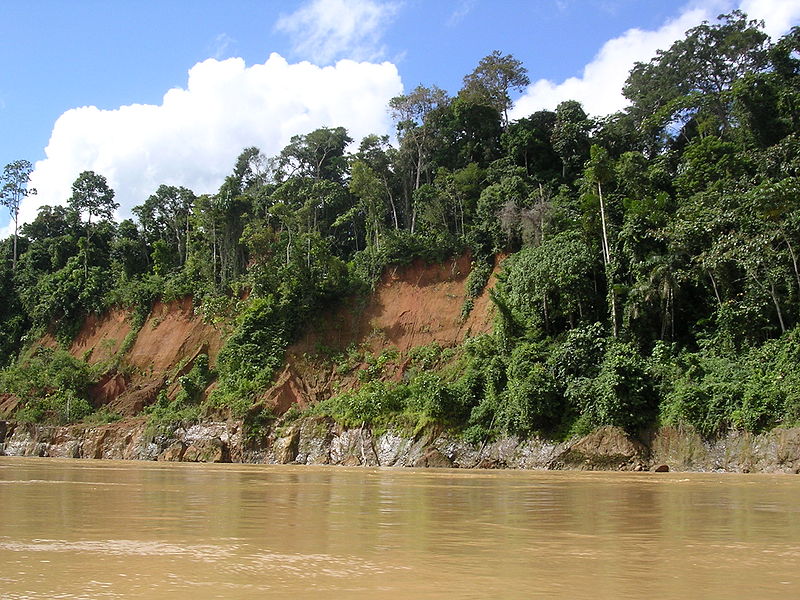 Rural Amazon villages typically hug the banks of the riverine waterways. But many of the villagers are now sighting a mysterious people occasionally emerging from their isolated habitats deep within the more secluded and untouched areas of the rainforest.
Rural Amazon villages typically hug the banks of the riverine waterways. But many of the villagers are now sighting a mysterious people occasionally emerging from their isolated habitats deep within the more secluded and untouched areas of the rainforest.
__________________________________________________
Now, informed by the past, anthropologists, Peruvian and Brazilian policymakers, social organizations and think-tanks are wrestling with the problem of developing a strategy for dealing with these emerging isolated forest tribes, including, and perhaps more importantly, the question of what has changed in the environment to precipitate their recent behavior. Logging, mining, drug trafficking, oil and gas exploration, and even missionaries and film crews have been cited as possible disruptors of an ecosystem that many scientists say is being shaken from its delicate natural balance. The rainforest has been critical to the florescence of thousands of species of plant and animal life for thousands of years—including the uncontacted forest tribes.
______________________________________
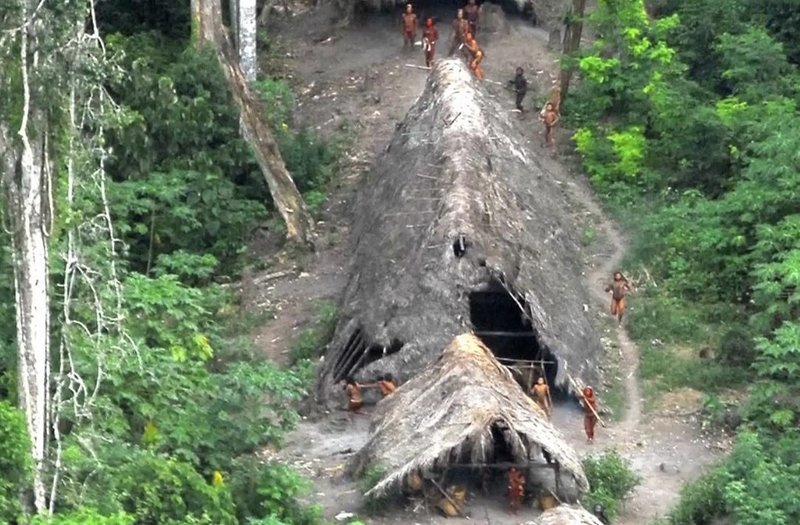 Above and below: A blast from the prehistoric past? More and more sightings are begging new questions – What is the ethical extent of modern intervention in their lives, what can we learn from them, and what is the extent of modern society’s moral obligation to ensure their continued survival and well-being? Still shots from the Science/AAAS video, Making contact, the isolated tribes of the Amazon rainforest (see video below) Courtesy Science/AAAS
Above and below: A blast from the prehistoric past? More and more sightings are begging new questions – What is the ethical extent of modern intervention in their lives, what can we learn from them, and what is the extent of modern society’s moral obligation to ensure their continued survival and well-being? Still shots from the Science/AAAS video, Making contact, the isolated tribes of the Amazon rainforest (see video below) Courtesy Science/AAAS
____________________________________________________
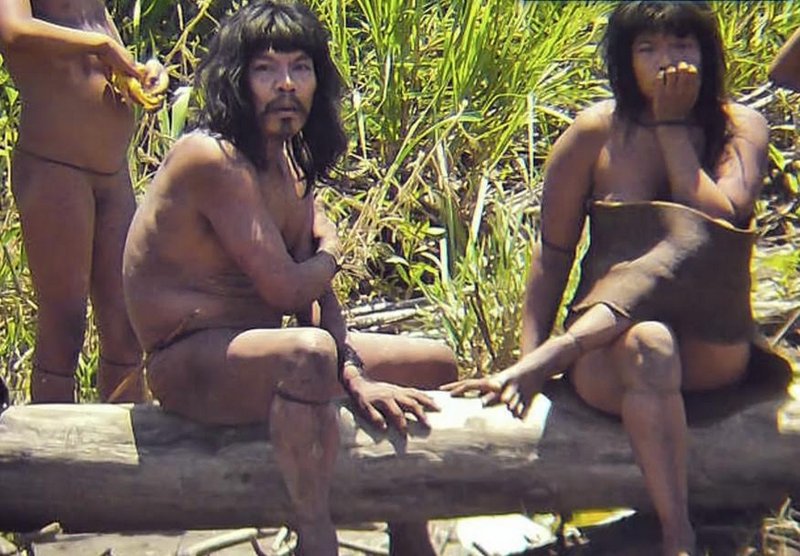 ___________________________________________________
___________________________________________________
 ____________________________________________________
____________________________________________________
Some anthropologists and archaeologists believe that knowing more about the Amazonian ancestral past could be a key to finding solutions for understanding and dealing with the forest people question.
At the 2015 annual meeting of the American Association for the Advancement of Science in San Jose, California, a group of scientists announced plans to scan the Amazon rainforest for signs of ancient settlements. The project, which has already been awarded a $1.9m grant from the European Research Council, will include conducting laser scans via drone. A major goal of the project will be to develop an understanding of the extent to which pre-Columbian populations built and flourished as far back as 3,000 years prior to the arrival of Europeans.
More than 400 geoglyphs have already been exposed by deforestation, suggesting collective, organized human behavior—an argument that has been an ongoing debate within New World archaeology.
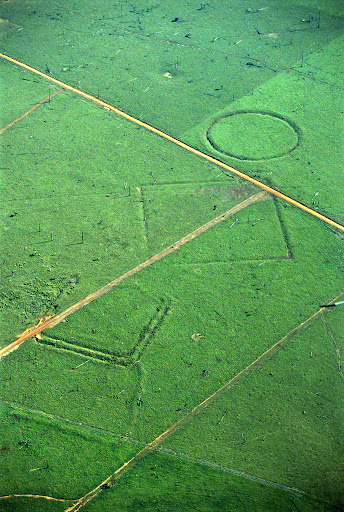 “Although humans have lived in Amazonia for the last 13,000 years, until recently, the long-accepted paradigm has been one of a noble savage living in harmony with the ancient forest, with negligible impact on the forest,” said Dr. José Iriarte of the University of Exeter, the lead researcher of the project. “Such a view was widely shared, not only among archaeologists, but also by most tropical ecologists whose interpretations of the biodiversity and ecological change were based on the assumption that this forest environment was largely pristine.”
“Although humans have lived in Amazonia for the last 13,000 years, until recently, the long-accepted paradigm has been one of a noble savage living in harmony with the ancient forest, with negligible impact on the forest,” said Dr. José Iriarte of the University of Exeter, the lead researcher of the project. “Such a view was widely shared, not only among archaeologists, but also by most tropical ecologists whose interpretations of the biodiversity and ecological change were based on the assumption that this forest environment was largely pristine.”
But, “based on mounting archaeological evidence that suggest the presence of complex Amazonian societies,” Iriarte continued, “at the other end of the spectrum are those that propose that the Amazon Basin was densely populated, perhaps up to 10 million inhabitants, and so intensively managed that by 1492 there was no such thing as a “virgin forest”— instead, it was a cultural parkland.”
Among other objectives, Iriarte hopes to test this idea of large, complex and hierarchical societies in the Amazon, known as the “cultural parkland hypothesis’, by conducting an intensive study of four distinct regions across the Amazon, implementing a battery of state-of-the-art techniques from the social and natural sciences, including archaeology, archaeobotany, ethnohistory, and paleoecology, in conjunction with remote sensing technology. Most notably, he and his team will be mounting LiDAR and multi-spectral sensors on UAVs (drones) beginning in the Fall of 2015 to scan large areas, comparing what they find to landscapes with areas already known to exhibit evidence of anthropogenic (human) manipulation of the landscape.
“It is only by applying this interdisciplinary approach that we can provide a holistic understanding of the origins of the modern Amazonian landscapes,” said Iriarte.
Even if and when Iriarte and his team come up with strong evidence supporting the ‘cultural parklands hypothesis’, they also hope to find answers to some other key questions. Issues of conservation and sustainability play a salient role.
“How did the 1492 Columbian encounter affect these landscapes and cultures?” asks Iriarte. “And did pre-Columbian land use have a lasting affect on the modern forest and, if so, how does the knowledge of the legacy of Late pre-Columbian groups inform modern conservation and sustainable agricultural practices for the future of the Amazon and other tropical regions of the world?”
Iriarte suggests that the outcome of the project could potentially guide policy-making in terms of land management and sustainability, and influence many other decisions that could otherwise be insufficiently informed without understanding past human management of the landscape.
Lawler reports that the isolated forest people, in response to the modern forces that increasingly surround and contain them, have already retreated as deeply as they can go into the last most secluded areas of the rainforest.
Could they be the last whimper and shadow of this ‘ancestral cultural parkland’, as Iriarte has penned?
Perhaps not directly. “These are not the uncontacted people of romantic imagination,” writes Lawler. “Most of these groups had traumatic interactions with industrial society about a century ago, when the upper Amazon filled with tens of thousands of outsiders eager to make a fortune from rubber.”* These indigenous forest dwellers, generations of whom were already skilled at tapping the sap of the rubber tree for their own, traditional needs, were exploited for little in return and, in more than a few cases, rewarded with death. They subsequently escaped to an isolated existence, abandoning their farming and former settlements to manage a living deep within the rainforest ecosystem. Bows and arrows, not the plow, became their most critical tool—much like the ancestors of most of the indigenous populations of South America, if one could glimpse back far enough into the collective past.
Scientists now hope that new chapters will be written about Amazon’s prehistory as future investigations collect the data needed to illuminate a past that has, for centuries, been shrouded beneath a jungle canopy. That is, of course, if enough of the rainforest can be saved to make the research meaningful.
_____________________________________
_____________________________________
*Lawler, Andrew, From deep in Peru’s rainforests, isolated people emerge, Science (online), 4 June 2015.
Image above: Geoglyphs discovered in cleared area of Amazon rainforest. Sanna Saunaluoma, Wikimedia Commons
______________________________________________
 Read more in-depth articles about archaeology with a premium subscription to Popular Archaeology Magazine.
Read more in-depth articles about archaeology with a premium subscription to Popular Archaeology Magazine.
In addition, the latest Popular Archaeology ebook is now available.
______________________________________________
Travel and learn with Far Horizons.
____________________________________________



____________________________________________



In addition, the latest Popular Archaeology ebook is now available.
______________________________________________
Travel and learn with Far Horizons.
____________________________________________



____________________________________________







